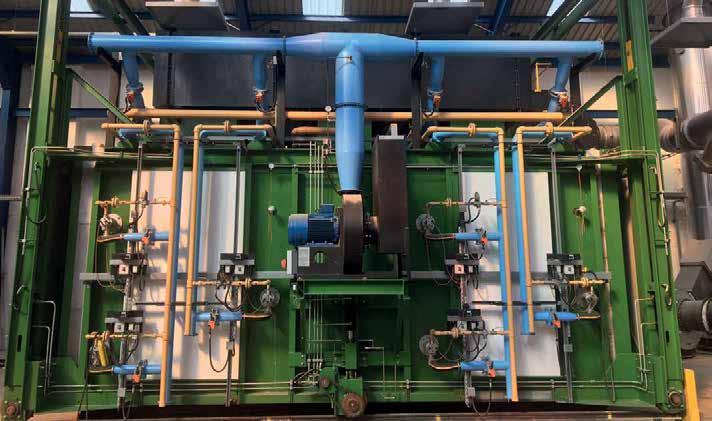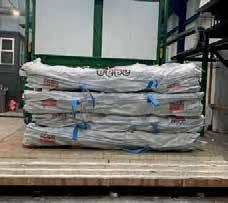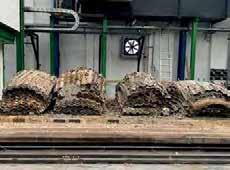
4 minute read
Thermal recycling
Worlds first commercially viable asbestos recycling plant established in the UK
Thermal recycling diverts asbestos containing material away from landfill, converts it into a new substance that is asbestos free, and that substance can then be used to produce a sustainable aggregate.
Traditionally the only viable method of disposing of asbestos has been to load asbestos waste into a skip and then empty that skip into a landfill site. Until now, there has been no alternative. With Thermal Recycling there is now an alternative which can eradicate asbestos permanently.
Thermal Recycling completed the commissioning of a demonstration plant just outside of Wolverhampton to demonstrate that transforming asbestos into an inert aggregate is possible and can be carried out safely and efficiently. Thermal Recycling currently have an Environment Agency (EA) permit to treat 29,500 tonnes per year.
The process denatures the asbestos by applying intense heat. Denaturing is a process that changes the essential characteristics of a substance, so it is no longer that substance. Heat is applied in a controlled, precise and scientific way and this leads to a number of chemical and physical transformations of the material, so that by the end of the process what is left is no longer asbestos and no longer contains asbestos, it is a new substance.
During the testing phase of the project, over 350 samples of the denatured asbestos material were tested after it had been treated in the kiln. Following analysis, all samples were reported as ‘No Asbestos Detected’. It was clear that the treated material was no longer hazardous with regards to asbestos, but was it safe with regards to other substances which may be present? Samples of the material were taken and analysed using X-ray diffraction and X-ray fluorescence to understand the chemical and crystalline structure of the material. The conclusion was that the treated material was no more hazardous than the Portland cement from which it was derived.
The kiln is unique and has been designed specifically for this new process. It is a moving hood kiln which lifts, moves along, and is repositioned over a kiln base. It has a burner system which has a tight temperature control of the heat which is applied. The fully enclosed system includes an after-burner system and a filtration system which removes the volatile organic compounds and other fumes and particulate matter from the exhaust emissions. The emissions are fully cleaned prior to exhausting to atmosphere.
The asbestos cement sheets are delivered from construction sites to the treatment plant in specially designed easy to load bags. The bags are loaded onto the kiln base and then the hooded kiln system is moved over the base. Heat is applied to the material in the kiln and the denaturing process begins. It takes 24 hours for the entire load to be denatured. Once the material has cooled it is removed from the kiln and crushed to produce the recyclable aggregate. The whole plant has a High Efficiency Particulate Arrestor (HEPA) filtered Local Exhaust Ventilation (LEV) system to remove any dust in the workplace atmosphere and operates at a rate of 5 air changes per hour.
So far 80 tonnes of material have been

processed through the demonstration plant and over 350 samples of the treated material have been taken from over 1,800 different sheets. The samples were analysed using Phased Light Microscopy (PLM), as well as samples being analysed using Scanning Electron Microscopy (SEM). Samples were also analysed by the Health and Safety Executive Laboratory (HSL) using Transmission Electron Microscopy (TEM). In all the analysis undertaken no asbestos was detected in any of the samples.
The sampling plan was agreed in advance with the Environment Agency and was designed with the assistance of a university statistician to ensure that the results were statistically valid. The scale and nature of the sampling undertaken proved that had any asbestos actually been present after the asbestos containing sheets had been fired in the kiln there was an extremely high probability that it would have been detected. The results were consistent with the fact that the sheets had been converted into a new substance that does not contain asbestos.
Thermal Recycling have recently received a Smart Innovation grant from the UK Government to investigate the highest value use for the recyclable material produced by the process. The next steps are to build a fullscale plant as soon as possible to do so and as soon as Thermal Recycling know they have the support and interest of the asbestos industry for that to be done.
Thermal Recycling know that their technology can treat all types of asbestos. Currently their EA permit only allows for treating cement bound asbestos containing chrysotile. Graham Gould, Thermal Recycling Chairman said, ‘We know the process can work for other types of asbestos and we want to work with the Environment Agency to extend the range of types of asbestos that we can treat. We want to establish a network of treatment plants across the UK and internationally so that we can treat as much asbestos as possible and divert it away from landfill’.
More information can be found at www.thermalrecycling.co.uk
Asbestos cement sheets are delivered from construction sites to the treatment plant in specially designed easy to load bags.

Denatured material after the 24 hour process. Once the material has cooled it is removed from the kiln and crushed to produce the recyclable aggregate.










